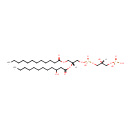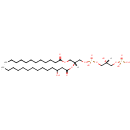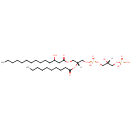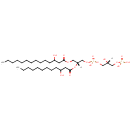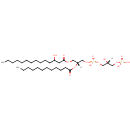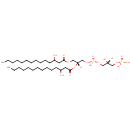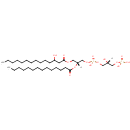
Search Results for compounds
Searching compounds for
returned 4373 results.
Displaying compounds 2571 - 2580 of
4373 in total
PGP(12:0/10:0(3-OH)) (PAMDB006560)
IUPAC:
[(2R)-3-({[(2R)-3-(dodecanoyloxy)-2-[(3-hydroxydecanoyl)oxy]propoxy](hydroxy)phosphoryl}oxy)-2-hydroxypropoxy]phosphonic acid
CAS: Not Available
Description: PGP(12:0/10:0(3-OH)) belongs to the class of glycerophosphoglycerophosphates, also called phosphatidylglycerophosphates (PGPs). These lipids contain a common glycerophosphate skeleton linked to at least one fatty acyl chain and a glycero-3-phosphate moiety. As is the case with diacylglycerols, phosphatidylglycerophosphates can have many different combinations of fatty acids of varying lengths and saturation attached to the C-1 and C-2 positions. PGP(12:0/10:0(3-OH)), in particular, consists of one dodecanoyl chain to the C-1 atom, and one 3-hydroxydecanoyl to the C-2 atom. In Pseudomonas aeruginosa, PGPs can be found in the cytoplasmic membrane. The are synthesized by the addition of glycerol 3-phosphate to a CDP-diacylglycerol. In turn, PGPs are dephosphorylated to Phosphatidylglycerols (PGs) by the enzyme Phosphatidylglycerophosphatase.
PGP(12:0/12:0(3-OH)) (PAMDB006561)
IUPAC:
[(2R)-3-({[(2R)-3-(dodecanoyloxy)-2-[(3-hydroxydodecanoyl)oxy]propoxy](hydroxy)phosphoryl}oxy)-2-hydroxypropoxy]phosphonic acid
CAS: Not Available
Description: PGP(12:0/12:0(3-OH)) belongs to the class of glycerophosphoglycerophosphates, also called phosphatidylglycerophosphates (PGPs). These lipids contain a common glycerophosphate skeleton linked to at least one fatty acyl chain and a glycero-3-phosphate moiety. As is the case with diacylglycerols, phosphatidylglycerophosphates can have many different combinations of fatty acids of varying lengths and saturation attached to the C-1 and C-2 positions. PGP(12:0/12:0(3-OH)), in particular, consists of one dodecanoyl chain to the C-1 atom, and one 3-hydroxydodecanoyl to the C-2 atom. In Pseudomonas aeruginosa, PGPs can be found in the cytoplasmic membrane. The are synthesized by the addition of glycerol 3-phosphate to a CDP-diacylglycerol. In turn, PGPs are dephosphorylated to Phosphatidylglycerols (PGs) by the enzyme Phosphatidylglycerophosphatase.
PGP(12:0/14:0(3-OH)) (PAMDB006562)
IUPAC:
[(2R)-3-({[(2R)-3-(dodecanoyloxy)-2-[(3-hydroxytetradecanoyl)oxy]propoxy](hydroxy)phosphoryl}oxy)-2-hydroxypropoxy]phosphonic acid
CAS: Not Available
Description: PGP(12:0/14:0(3-OH)) belongs to the class of glycerophosphoglycerophosphates, also called phosphatidylglycerophosphates (PGPs). These lipids contain a common glycerophosphate skeleton linked to at least one fatty acyl chain and a glycero-3-phosphate moiety. As is the case with diacylglycerols, phosphatidylglycerophosphates can have many different combinations of fatty acids of varying lengths and saturation attached to the C-1 and C-2 positions. PGP(12:0/14:0(3-OH)), in particular, consists of one dodecanoyl chain to the C-1 atom, and one 3-hydroxytetradecanoyl to the C-2 atom. In Pseudomonas aeruginosa, PGPs can be found in the cytoplasmic membrane. The are synthesized by the addition of glycerol 3-phosphate to a CDP-diacylglycerol. In turn, PGPs are dephosphorylated to Phosphatidylglycerols (PGs) by the enzyme Phosphatidylglycerophosphatase.
PGP(12:0/19:iso) (PAMDB006563)
IUPAC:
Not Available
CAS: Not Available
Description: PGP(12:0/19:iso) belongs to the class of glycerophosphoglycerophosphates, also called phosphatidylglycerophosphates (PGPs). These lipids contain a common glycerophosphate skeleton linked to at least one fatty acyl chain and a glycero-3-phosphate moiety. As is the case with diacylglycerols, phosphatidylglycerophosphates can have many different combinations of fatty acids of varying lengths and saturation attached to the C-1 and C-2 positions. PGP(12:0/19:iso), in particular, consists of one dodecanoyl chain to the C-1 atom, and one 17-methylocatdecanoyl to the C-2 atom. In Pseudomonas aeruginosa, PGPs can be found in the cytoplasmic membrane. The are synthesized by the addition of glycerol 3-phosphate to a CDP-diacylglycerol. In turn, PGPs are dephosphorylated to Phosphatidylglycerols (PGs) by the enzyme Phosphatidylglycerophosphatase.
PGP(14:0(3-OH)/10:0(3-OH)) (PAMDB006564)
IUPAC:
[(2R)-2-hydroxy-3-({hydroxy[(2R)-2-[(3-hydroxydecanoyl)oxy]-3-[(3-hydroxytetradecanoyl)oxy]propoxy]phosphoryl}oxy)propoxy]phosphonic acid
CAS: Not Available
Description: PGP(14:0(3-OH)/10:0(3-OH)) belongs to the class of glycerophosphoglycerophosphates, also called phosphatidylglycerophosphates (PGPs). These lipids contain a common glycerophosphate skeleton linked to at least one fatty acyl chain and a glycero-3-phosphate moiety. As is the case with diacylglycerols, phosphatidylglycerophosphates can have many different combinations of fatty acids of varying lengths and saturation attached to the C-1 and C-2 positions. PGP(14:0(3-OH)/10:0(3-OH)), in particular, consists of one 3-hydroxytetradecanoyl chain to the C-1 atom, and one 3-hydroxydecanoyl to the C-2 atom. In Pseudomonas aeruginosa, PGPs can be found in the cytoplasmic membrane. The are synthesized by the addition of glycerol 3-phosphate to a CDP-diacylglycerol. In turn, PGPs are dephosphorylated to Phosphatidylglycerols (PGs) by the enzyme Phosphatidylglycerophosphatase.
PGP(14:0(3-OH)/10:0) (PAMDB006565)
IUPAC:
[(2R)-3-({[(2R)-2-(decanoyloxy)-3-[(3-hydroxytetradecanoyl)oxy]propoxy](hydroxy)phosphoryl}oxy)-2-hydroxypropoxy]phosphonic acid
CAS: Not Available
Description: PGP(14:0(3-OH)/10:0) belongs to the class of glycerophosphoglycerophosphates, also called phosphatidylglycerophosphates (PGPs). These lipids contain a common glycerophosphate skeleton linked to at least one fatty acyl chain and a glycero-3-phosphate moiety. As is the case with diacylglycerols, phosphatidylglycerophosphates can have many different combinations of fatty acids of varying lengths and saturation attached to the C-1 and C-2 positions. PGP(14:0(3-OH)/10:0), in particular, consists of one 3-hydroxytetradecanoyl chain to the C-1 atom, and one decanoyl to the C-2 atom. In Pseudomonas aeruginosa, PGPs can be found in the cytoplasmic membrane. The are synthesized by the addition of glycerol 3-phosphate to a CDP-diacylglycerol. In turn, PGPs are dephosphorylated to Phosphatidylglycerols (PGs) by the enzyme Phosphatidylglycerophosphatase.
PGP(14:0(3-OH)/12:0(3-OH)) (PAMDB006566)
IUPAC:
[(2R)-2-hydroxy-3-({hydroxy[(2R)-2-[(3-hydroxydodecanoyl)oxy]-3-[(3-hydroxytetradecanoyl)oxy]propoxy]phosphoryl}oxy)propoxy]phosphonic acid
CAS: Not Available
Description: PGP(14:0(3-OH)/12:0(3-OH)) belongs to the class of glycerophosphoglycerophosphates, also called phosphatidylglycerophosphates (PGPs). These lipids contain a common glycerophosphate skeleton linked to at least one fatty acyl chain and a glycero-3-phosphate moiety. As is the case with diacylglycerols, phosphatidylglycerophosphates can have many different combinations of fatty acids of varying lengths and saturation attached to the C-1 and C-2 positions. PGP(14:0(3-OH)/12:0(3-OH)), in particular, consists of one 3-hydroxytetradecanoyl chain to the C-1 atom, and one 3-hydroxydodecanoyl to the C-2 atom. In Pseudomonas aeruginosa, PGPs can be found in the cytoplasmic membrane. The are synthesized by the addition of glycerol 3-phosphate to a CDP-diacylglycerol. In turn, PGPs are dephosphorylated to Phosphatidylglycerols (PGs) by the enzyme Phosphatidylglycerophosphatase.
PGP(14:0(3-OH)/12:0) (PAMDB006567)
IUPAC:
[(2R)-3-({[(2R)-2-(dodecanoyloxy)-3-[(3-hydroxytetradecanoyl)oxy]propoxy](hydroxy)phosphoryl}oxy)-2-hydroxypropoxy]phosphonic acid
CAS: Not Available
Description: PGP(14:0(3-OH)/12:0) belongs to the class of glycerophosphoglycerophosphates, also called phosphatidylglycerophosphates (PGPs). These lipids contain a common glycerophosphate skeleton linked to at least one fatty acyl chain and a glycero-3-phosphate moiety. As is the case with diacylglycerols, phosphatidylglycerophosphates can have many different combinations of fatty acids of varying lengths and saturation attached to the C-1 and C-2 positions. PGP(14:0(3-OH)/12:0), in particular, consists of one 3-hydroxytetradecanoyl chain to the C-1 atom, and one dodecanoyl to the C-2 atom. In Pseudomonas aeruginosa, PGPs can be found in the cytoplasmic membrane. The are synthesized by the addition of glycerol 3-phosphate to a CDP-diacylglycerol. In turn, PGPs are dephosphorylated to Phosphatidylglycerols (PGs) by the enzyme Phosphatidylglycerophosphatase.
PGP(14:0(3-OH)/14:0(3-OH)) (PAMDB006568)
IUPAC:
[(2R)-3-({[(2R)-2,3-bis[(3-hydroxytetradecanoyl)oxy]propoxy](hydroxy)phosphoryl}oxy)-2-hydroxypropoxy]phosphonic acid
CAS: Not Available
Description: PGP(14:0(3-OH)/14:0(3-OH)) belongs to the class of glycerophosphoglycerophosphates, also called phosphatidylglycerophosphates (PGPs). These lipids contain a common glycerophosphate skeleton linked to at least one fatty acyl chain and a glycero-3-phosphate moiety. As is the case with diacylglycerols, phosphatidylglycerophosphates can have many different combinations of fatty acids of varying lengths and saturation attached to the C-1 and C-2 positions. PGP(14:0(3-OH)/14:0(3-OH)), in particular, consists of two 3-hydroxytetradecanoyl chains at positions C-1 and C-2. In Pseudomonas aeruginosa, PGPs can be found in the cytoplasmic membrane. The are synthesized by the addition of glycerol 3-phosphate to a CDP-diacylglycerol. In turn, PGPs are dephosphorylated to Phosphatidylglycerols (PGs) by the enzyme Phosphatidylglycerophosphatase.
PGP(14:0(3-OH)/14:0) (PAMDB006569)
IUPAC:
[(2R)-2-hydroxy-3-({hydroxy[(2R)-3-[(3-hydroxytetradecanoyl)oxy]-2-(tetradecanoyloxy)propoxy]phosphoryl}oxy)propoxy]phosphonic acid
CAS: Not Available
Description: PGP(14:0(3-OH)/14:0) belongs to the class of glycerophosphoglycerophosphates, also called phosphatidylglycerophosphates (PGPs). These lipids contain a common glycerophosphate skeleton linked to at least one fatty acyl chain and a glycero-3-phosphate moiety. As is the case with diacylglycerols, phosphatidylglycerophosphates can have many different combinations of fatty acids of varying lengths and saturation attached to the C-1 and C-2 positions. PGP(14:0(3-OH)/14:0), in particular, consists of one 3-hydroxytetradecanoyl chain to the C-1 atom, and one tetradecanoyl to the C-2 atom. In Pseudomonas aeruginosa, PGPs can be found in the cytoplasmic membrane. The are synthesized by the addition of glycerol 3-phosphate to a CDP-diacylglycerol. In turn, PGPs are dephosphorylated to Phosphatidylglycerols (PGs) by the enzyme Phosphatidylglycerophosphatase.

